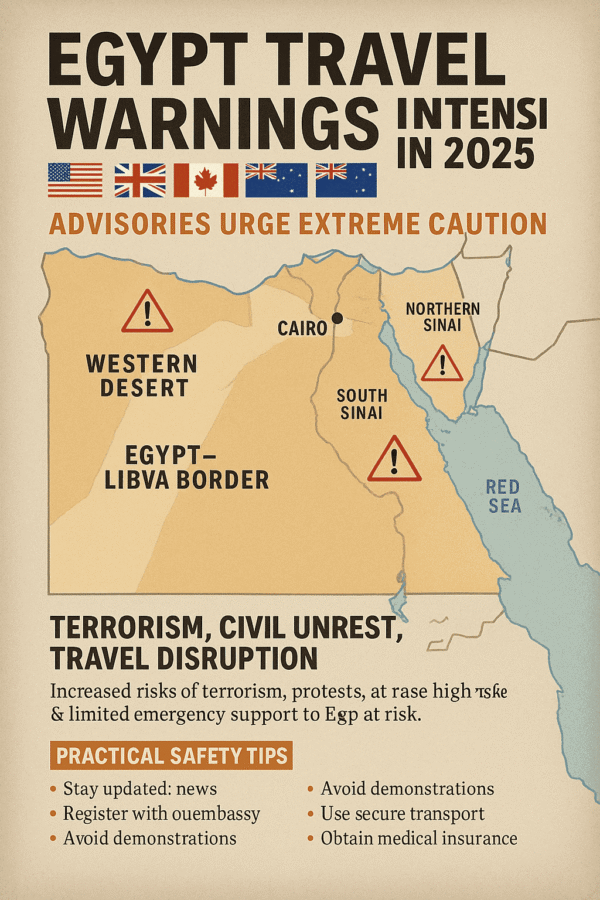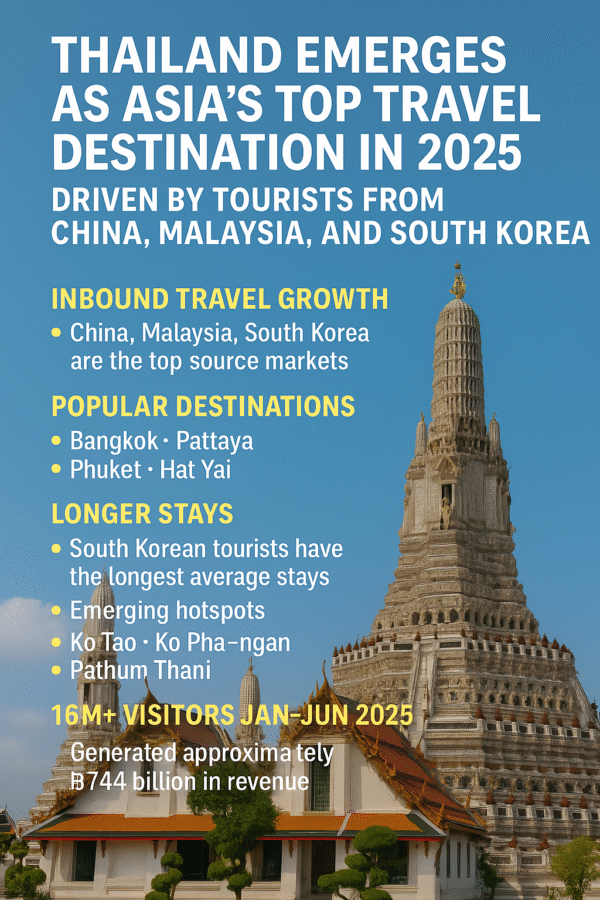Thailand has firmly established itself as Asia’s most sought-after travel destination in 2025, fueled by a historic influx of international tourists—most notably from China, Malaysia, and South Korea. According to the latest Agoda travel insights, the country’s inbound tourism figures are breaking records, affirming the kingdom’s growing appeal and positioning it at the forefront of regional tourism.
This exponential growth comes on the heels of Thailand’s dynamic Amazing Thailand Grand Tourism and Sports Year 2025 campaign, a nationwide initiative that is enhancing air connectivity, streamlining entry procedures, and promoting diverse cultural and recreational experiences across the country.
China, Malaysia, and South Korea: Leading Tourism Growth
Agoda’s mid-year analysis highlights that China remains the largest source market for Thailand, driven by the return of outbound Chinese travel post-pandemic and expanded flight routes between major cities and Bangkok, Phuket, and Chiang Mai.
Malaysia and South Korea follow closely, contributing significantly to both visitor volume and tourism spending. These figures reflect not just proximity and strong diplomatic ties but also Thailand’s ongoing efforts to strengthen air routes and travel incentives for neighboring markets.
Additional key source markets include Japan and Singapore, both of which continue to send high-value tourists interested in wellness retreats, culinary experiences, and heritage travel.
Thailand’s Top Destinations: Bangkok, Phuket, Pattaya, and Hat Yai
Unsurprisingly, Bangkok, Pattaya, and Phuket remain the most visited cities in 2025. Their well-developed infrastructure, world-class hotels, iconic landmarks, and ease of access continue to draw millions from across Asia.
However, Hat Yai, a southern city near the Malaysian border, has emerged as a surprise leader among regional tourists—particularly Malaysians and Singaporeans. According to Agoda, Hat Yai’s affordable accommodation, rich street food culture, and vibrant markets have secured its spot as one of Asia’s most budget-friendly destinations for the second year running.
Travel Trends: South Koreans Lead in Length of Stay
While Chinese tourists dominate in terms of sheer volume, South Korean travelers stand out for their extended stays, with many opting for trips lasting over a week. This trend indicates a shift toward more immersive travel, with visitors seeking deeper cultural experiences rather than short, city-centric getaways.
Following South Korea, travelers from Japan, Singapore, Malaysia, and China also show a strong preference for longer holidays, contributing to higher per-visitor spending and supporting local economies across various provinces.
Emerging Hotspots: Ko Tao, Ko Pha-ngan, and Pathum Thani
Beyond the usual tourist hotspots, travelers are increasingly venturing into quieter, off-the-beaten-path destinations. Agoda reports a notable rise in long-stay bookings for:
Ko Tao – Known for its spectacular diving and coral reefs, Ko Tao remains a favorite among adventure seekers.
Ko Pha-ngan – Once famous primarily for its Full Moon parties, the island now attracts travelers in search of wellness retreats and secluded beaches.
Pathum Thani – Located just north of Bangkok, this lesser-known province offers a blend of riverside charm, local markets, and temples without the crowds.
These emerging destinations are gaining traction among visitors looking for a more authentic Thai experience and reflect a broader shift toward eco-conscious and cultural tourism.
Tourism Revenue Surpasses Expectations in 2025
According to the Ministry of Tourism and Sports, Thailand received over 16 million international visitors in the first six months of 2025. This surge generated an estimated 743.58 billion baht (USD 20 billion) in revenue—a remarkable rebound for the sector.
This achievement follows key tourism reforms, including:
Visa policy improvements, such as easier e-visa access and visa-free agreements with multiple Asian countries.
Expanded regional flights, particularly low-cost carriers operating from secondary cities.
Promotion of sustainable tourism, through community-based experiences and environmental preservation efforts.
The Tourism Authority of Thailand (TAT) has emphasized that this success is not just about numbers but about delivering quality, inclusive travel experiences that benefit local communities and support long-term growth.
What This Means for Travelers in 2025
For those planning a trip to Thailand, the surge in regional visitors means greater availability of direct flights, enhanced tourism infrastructure, and more localized travel experiences than ever before. With the Amazing Thailand Grand Tourism and Sports Year campaign in full swing, travelers can expect special promotions, sporting events, and cultural showcases in major cities and rural provinces alike.
Popular attractions such as Wat Arun, Phi Phi Islands, and Doi Inthanon are being reimagined through smart tourism technology and crowd management to ensure both accessibility and sustainability.
Conclusion: Thailand’s Tourism Future Looks Bright
Thailand’s 2025 tourism boom is being driven by robust inbound travel from regional markets, smart government campaigns, and traveler preferences shifting toward longer, more meaningful stays. With a unique mix of modern convenience, cultural richness, and natural beauty, Thailand remains the crown jewel of Asian tourism.
Whether you’re flying in from Beijing, Kuala Lumpur, Seoul, Tokyo, or Singapore, there’s never been a better time to explore what Thailand has to offer—from the golden temples of Bangkok to the serene bays of the southern islands. With growth showing no signs of slowing, Thailand is on course to exceed its tourism goals and redefine the future of travel in Asia.
Let me know if you’d like a custom AI-generated image to pair with this story for publication or social media.
For more travel news like this, keep reading Global Travel Wire


















